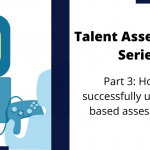Written by Ash
•
•
Imagine if you could mimic the process pilots take before flying a real plane with your business leaders, where they fly over hundreds of hours in a flight simulator learning different scenarios that could happen and making all mistakes needed in a zero-impact environment before commercially taking the yoke. Business simulations allow just that by placing candidates in a life-like environment with intelligent back-end algorithms to experiment, learn different scenarios, and fail safely before applying it to the organization.
What Are Business Simulations?
Business simulations refer to any interactive activity that simulates actual business scenarios and aims to help leaders build capability by letting them experiment, learn and fail in a zero-risk environment. The traditional approach to business simulations was board-game simulations in which participants use a canvas much like the board games we play, but scenarios are business-related and soft skills become a big part of it. The new approach discussed in this article is online business simulations in which participants engage in the simulation virtually, and the possibilities of learning expand drastically as more data points can be collected about the candidate’s performance and choices. This new approach also allows for simulations to be done remotely, do not require facilitation, and can be customized based on organizational or market needs quickly, making them suitable for both talent acquisition and L&D teams.
Although business simulations can be crafted to suit many business and capability building needs, below are some of the widespread use cases for simulations both in recruitment and development:
- Business Acumen and Strategy – Understand the candidate’s ability to manage the organization in the areas that most impact profitability and growth. Put them in the driver’s seat and see how they perform at managing cash flows and balance sheets, competitor research, and market reports, headcount and productivity decisions, etc.
- Leadership – Understand the candidate’s natural leadership style when given a team of people who all have multiple dynamics. Stepping in to lead a group can be detrimental to current performance if the leadership style does not resonate with members; therefore, allow them to understand how to read the team chemistry and experiment with different approaches with individuals.
- Sales Acumen – Understand the candidate’s approach to navigating sales conversations and cycles and their product knowledge. Starting a sales process requires good product knowledge and confidence, and skills such as negotiating, handling objections, and customer product fit. Simulate customer scenarios instead of losing real customers.
- Change Management – Understand the candidate’s ability and approach to being a change agent, drive an idea to adoption, and help candidates understand the strategic and tactical aspects of change management. Either simulate candidates having a position of authority or not, they will need to navigate stakeholders with the idea of bringing transformation.
- In-Tray – Understand the candidate’s approach to managing an influx of work in which quick decisions are needed to clear this workload. See how they decide between delegating, prioritizing, and executing tasks while juggling new work that enters.
Why Use Business Simulations?
Recruitment and L&D teams both have had trouble assessing/developing candidates for real-world scenarios that were not costly or resource-heavy and business simulations are the answer. Using simulations, recruitment teams are able to select the candidate best suited for their current business needs and ensure a quicker time to perform. L&D teams are able to build behavioral capabilities that usually take years to accomplish through immersive learning. The key benefits business simulations bring to a company are:
- Reflective of the real world. Simulations emulate the real-world factors and challenges that organizations face and are able to give candidates a view of on the job challenges.
- Risk-free environment. Candidates can learn from their mistakes and witness the consequences of their actions in a safe setting without impacting your organisation.
- Learning by experience. Using the study that we remember 80% of personal experience but only 10% of what we read, retention becomes higher through simulations.
- Higher learning engagement. Due to its experiential and hands-on nature simulations are proven to higher learning engagement rates which in turn produces better L&D ROI.
Accelerated learning. Simulations give participants a bird’s-eye view of processes, allowing them to understand a wide range of concepts and materials in a short amount of time. Stickiness is increased when new learnings are linked back to the organization’s problems.
What to consider when choosing a Business Simulation provider?
1. Availability of multiple simulations
Certain providers in the simulation space prefer to specialize in one area of simulations; for example, they may have a highly specialized simulation in only Leadership or 2-3 simulation only measuring Business Acumen. However, some providers create a wide range of simulations aimed at measuring multiple business areas. It is advantageous to choose the latter when mapping simulations to your organization. There will be a need for different simulations at different job levels and even at different job roles. This way, simulations are consistent in their supplier, and the procurement process is only done once.
2. Facilitated and non-facilitated support
Depending on the use case of your business simulation, you may need a facilitator to conduct the simulation with learnings. Typically, simulations used during a recruitment process will not be facilitated as the candidate is in an assessment situation. As opposed to that, simulations done for promotional exercise or development programs will need a facilitator to either ensure the simulation process goes smoothly or provide direct learning feedback. As your organization scales its use of simulations, choosing a provider that can support your organization with both is advantageous.
3. Frequency of updates
Due to the constantly changing nature of business, requirements of skills, capabilities, and talents also constantly change. Therefore, simulations in their design also need to be continually evolving to either be updated with the market or for new simulations to be created for emerging skills. Selecting a provider that has shown proof of updating their portfolio will be advantageous because should a new business need arise, they will support your organization.
Gaining The Most Out Of Business Simulations
1. Map Simulations To Job Levels
Like every Talent Assessment tool, business simulations vary in what they measure and therefore need to be mapped accordingly to different job levels to ensure accurate results. Organizations need to look into what is required at each job level before starting the search for business simulations. A mapping matrix can then be created that ensures tool accuracy. As an example, refer to the mapping matrix below.
| Job Level | Job Requires | Simulation | Competencies Measured |
| C Level | The leadership of business direction and strategy, growth of the business, shareholder management | Business Simulation | Business Acumen, Strategic Thinking, Market Orientation, Competitor Analysis |
| Senior Manager | Top-level before c-suite, head of multiple business units, communication of business direction | Business Simulation Change Management Simulation | Business Acumen, Strategic Execution, Influencing Skill, Change Management |
| Middle Manager | A bridge between senior and first-line managers for strategy and execution | Change Management Simulation Leadership Simulation | Influencing Skill, Leadership Without Authority, People Management, Performance Management |
| First Line Manager | Direct people manager responsible for reporting the execution of strategy | Leadership Simulation Project Management Simulation | Contextual Leadership, People Management, Team Development, Problem Solving |
| Executive | Executors of business strategy, operationally driven | Project Management Influence Simulation | Problem Solving, Collaboration, Trust Building, Understanding Networks |
| Non-executive | Business support | In-Tray Simulation | Prioritization, Delegation, Responsiveness |
Mapping Matrix Table
The other benefit of creating a mapping matrix according to your organization’s needs is it actually brings out a certain overlap of responsibilities and competencies amongst certain job levels and therefore certain simulations are able to be used across levels saving the organization cost.
2. Administer Simulations Correctly
The way that simulations are administered can significantly impact the results and their usefulness to the organization. Methods of administration come in two forms, facilitated or unfacilitated, and the use of either one heavily depends on where in the process it is being used. This is an essential factor to match according to use because it would heavily impact the cost and user experience. Let’s take a look at both methods to understand how it affects the use cases.
- Unfacilitated – Unfacilitated sessions are typically used in the recruitment process in which candidates receive email invites with instructions on how to perform the simulation. A key reason for this is logistics, as recruitment pools are usually large in volume and can span geographic territories. Simulations used here aim at assessing rather than developing; therefore, they are typically kept shorter, have a shorter or no candidate report, and are not followed up with a theoretical explanation of the simulation logic.
- Facilitated – Facilitated sessions are most popularly done in two scenarios; learning and development and internal mobility, especially senior roles. In learning and development, facilitators play the role of trainers. They explain the theoretical concept behind the simulation before or after the exercise for candidates to understand how to apply them to real situations. Here, simulation times are usually longer with a development-centric report, so candidates genuinely see what they did wrong or right. For internal mobility purposes, simulations are part of the assessment process in finding suitable candidates for suitable roles. Although simulations are shortened similarly to the assessment use case, facilitators are there only for instructional purposes and to ensure internal candidates have a great experience.
3. Create A Continuous Process
Just as flight simulators are not a one-time use, business simulations shouldn’t be either. Organizations must account for various changes, such as market, business, structure, culture, and individual after a candidate has gone through simulations, whether for assessment or development. A candidate can retake a simulation and do much better than before, or worse, depending on the experiences he’s gone through in that time. Also, because there is no one way, rather many ways, to highly perform at a simulation, candidates find new ways to do real-world tasks by constantly being put in a loop or learning and retaking.
This is why simulations are often used as learning milestones in Individual Development Plans (IDPs). Many companies develop employee IDPs after some level of assessments and performance feedback process and create an extensive 16-18 months plan with technical, knowledge competency-based gaps the employee should aim to close. Then, money is spent on training programs and learning courses to assist the employees, but sadly most do not see an impact and ROI. Because experiential learning has been proven to be much more effective than traditional learning, adding simulations as an avenue for employees to execute their learnings with immediate feedback ensures retention. When planned into development properly, simulations can tap into valid learning models such as the one below.

Conclusion: A Case Study On Business Simulations ROI
The most significant proof of business simulations being used successfully is when true business impact can be shown. Business simulation provider Knolskape achieved just this for their client TATA Business Support Services (TBSS), one of India’s leading business process outsourcing companies, who needed to revamp their traditional assessment center for senior leadership development after receiving unhappy feedback on their previous method. With a growth rate of 15% per year, they needed to prepare their leadership pipeline to achieve their Vision 2020 target. Revamping the approach to assessment centers, Knolskape helped TBSS achieve 45% cost savings compared to their previous approach, reduce assessment execution time by 70% and align solution design and delivery to TBSS’s vision of embracing digital.
Additional Resources for Business Simulations
- Succession Planning
- Succession Planning E Book
- Succession Planning Ultimate Guide
- Succession Planning Checklist
- Succession Planning Model
- Succession Planning toolkit
- Succession Planning How To Avoid Promoting the Wrong Person
- Succession Planning HR buyers guide
- Succession Planning needs
- Succession Planning white paper
- Poor Succession Planning
- Challenges of Succession Planning
Page Contents







